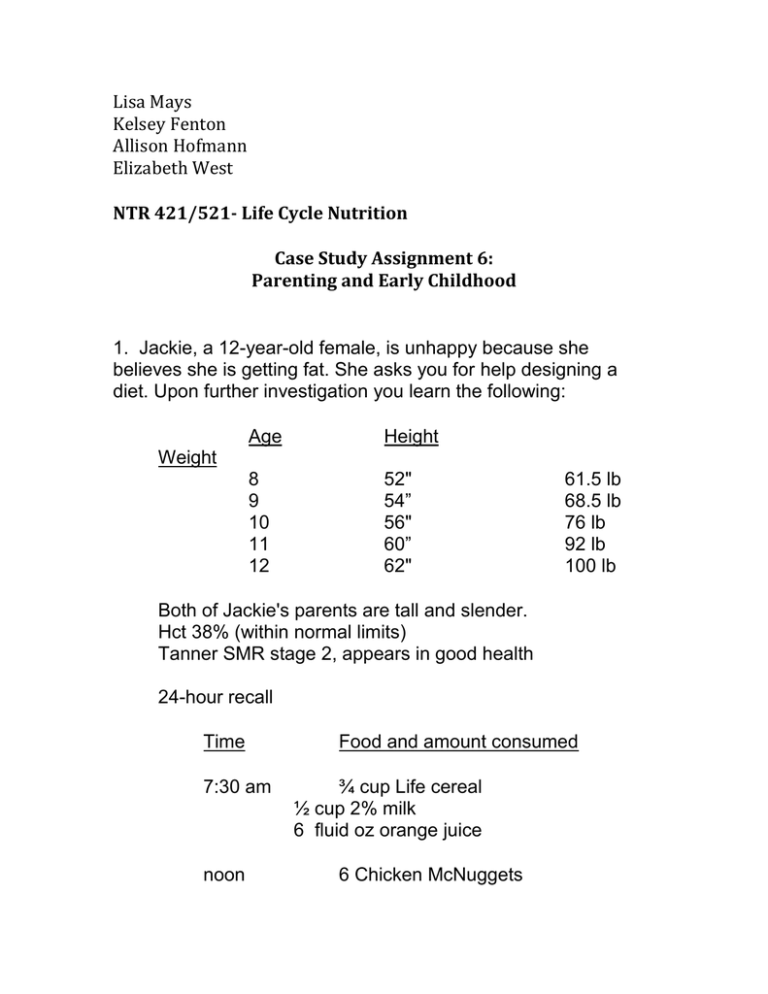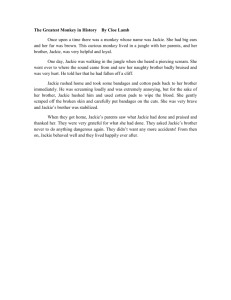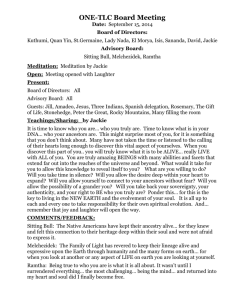Case study 2 Team project
advertisement

Lisa Mays Kelsey Fenton Allison Hofmann Elizabeth West NTR 421/521- Life Cycle Nutrition Case Study Assignment 6: Parenting and Early Childhood 1. Jackie, a 12-year-old female, is unhappy because she believes she is getting fat. She asks you for help designing a diet. Upon further investigation you learn the following: Age Height 8 9 10 11 12 52" 54” 56" 60” 62" Weight 61.5 lb 68.5 lb 76 lb 92 lb 100 lb Both of Jackie's parents are tall and slender. Hct 38% (within normal limits) Tanner SMR stage 2, appears in good health 24-hour recall Time 7:30 am noon Food and amount consumed ¾ cup Life cereal ½ cup 2% milk 6 fluid oz orange juice 6 Chicken McNuggets Small order of fries 12 fluid oz Coke apple pie (all at McDonalds) 3:30 pm 12 fluid oz diet iced tea 1 apple or orange 5:30 p.m. 3 oz. lean beef 1 dinner roll with 1 tsp margarine ½ cup rice with 1 tsp margarine ½ cup cooked green beans 12 fluid oz. root beer 7:00 pm 4 graham crackers 6 fluid oz. 2% milk Exercise: Jackie does not exercise regularly. Please write the question before each answer provided. 1. Evaluate Jackie’s growth. (30 points total) a. Plot Jackie’s growth on the appropriate growth chart. Complete the chart below providing the Growth Chart percentiles for each age. Provide the completed growth chart for full credit. To receive partial credit for wrong answers, you must show your work and provide the growth chart plots. (15 points) Age BMI BMI-for-Age Percentile 8 Years 9 Years 10 Years (43234.5)/(2704) = 16 (48155.5)/2916 = 16.5 (53428)/3136 = 17 50th - 75th 50th - 75th 50th 75th 11 Years 12 Year (64676)/3600 = 18 (70300)/3844 = 18.3 50th - 75th 50th - 75th b. Explain Jackie’s current weight status. Is she overweight, underweight, normal, or obese? What information/data are you using to draw this conclusion? (5 points) Jackie’s current weight status is normal. This is determined by her BMI falling within the 50th – 75th percentiles, which is within the 5th – 85th percentile range for normal weight. c. Explain Jackie’s growth pattern. Is it a “normal” growth pattern? Is there anything to be concern about? If yes, what are you concerned about? What information/data are you using to draw your conclusions for all questions? (5 points) Jackie’s growth pattern is normal. This is determined by her growth following a trajectory which falls reasonably within the parameters of a normal growth pattern as illustrated on the BMIfor-age and gender percentile chart. There is cause for concern for the fact that her rate of growth has declined slightly between years eleven and twelve. This concern is due to the chart illustration of a high rate of growth expected during this age, which is also consistent for expectations of age for entering a linear growth spurt in females. Questions should be asked about any changes in her eating habits and behavior, as well as growth patterns experienced during these ages by family members, an stature of additional family members. d. In 3 sentences or less, provide your overall interpretation and evaluation of Jackie’s weight and growth pattern. Hint: You may be repeating some of what you said in your previous answers. (5 points) Jackie is within the 50th – 75th percentiles of BMI-for-age and gender, which places her at normal weight status of between the 5th and 85th percentiles. Her growth pattern currently follows a normal trajectory as illustrated by this growth chart, though her rate of growth between years 11 and 12 has not increased as rapidly as may be expected with this age. Should her growth pattern continue to level, Jackie may need nutritional intervention. 2. Evaluate Jackie’s diet and make recommendations. (34 points total) a. Enter Jackie’s usual intake into MyPyramid.gov for using the MyPyramid tracker device. b. Provide a print out of: (8 points) i. Your diet entry ii. The analysis for Jackie’s diet based on the Dietary Guidelines (assume she is wanting to maintain his weight—even though we know this is not true) iii. Nutrient Intakes iv. The MyPyramid Recommendations. c. Based on the print-outs and the general description of Jackie’s diet, identify 3 key areas of concern in Jackie’s diet. (18 points) i. For each key area of concern, explain what information from Jackie’s diet you used to make your decision. ii. For each area of concern, explain why this is a concern/ what are the implications for Jackie’s growth, development, and/or health status. Areas of concern: 320, 369, 16/17, 371 1. Concern #1: Calcium a. What information used: Jackie is only consuming 697 mg of calcium on average per day when she should be consuming about 1300 mg. Most of this is coming from her 10 oz. of milk per day at breakfast and before bed. Jackie also drinks 2 sodas on average per day, which takes the place of nutrient-dense beverages such as milk and fortified juices. b. Why a concern? Implications for growth/development/health status? Adequate calcium intake during adolescence is crucial to physical growth and development. Calcium is the main constituent of bone mass and about half of a person’s peak bone mass is accrued during adolescence and puberty. Calcium is mandatory for the development of dense bone mass and adequate consumption of this nutrient, especially during adolescence, reduces the lifetime risk of fractures and osteoporosis. Calcium absorption rates are higher during adolescence than during any other time, except for infancy. Adolescent females appear to have the greatest calcium absorption rates around the time of the first menstruation, with rates decreasing after that. 2. Concern #2: Low intake of fruits and vegetables a. What information used: According to her 24hour food log, Jackie is consuming half of her recommended intake for fiber at 13 g/day. She eats few vegetables, only one piece of fresh fruit per day, and consumes white rice instead of brown rice. Her dinner roll is most likely not whole grain or whole wheat. On this dayJackie is consuming 293 mcg of vitamin A daily when optimum range is around 600 mcg. Jackie is consuming an average of 4.4 mg of vitamin E per day when the recommendations are that she consume at least 11 mg per day. b. Why a concern? Implications for growth/development/health status? The low intake of fruits, vegetables, and milk/dairy products by adolescents contributes to a less-than-ideal intake of fiber, vitamin A and vitamin E. Dietary fiber is important for normal bowel function and may play a role in the prevention of chronic diseases such as certain cancers, coronary artery disease, and type II diabetes. Adequate fiber intake is also thought to reduce serum cholesterol levels, to moderate blood sugar, and to reduce the risk of obesity. Low intake of fruits and vegetables, combined with an average intake of less than one serving of whole grains per day among adolescents, are contributing factors affecting low fiber intake among adolescents. Vitamin A is a fat-soluble vitamin needed for the formation and maintenance of mucous membranes, skin, and bone. It is especially important during adolescence when the body undergoes rapid growth and development. Vitamin E (alpha-tocopherol) acts as an antioxidant to prevent damage to cell membranes, blood cells, lungs, and other tissues. It repairs damage caused by free radicals in the body. The role of this vitamin is increasingly important as body mass expands during adolescence. Vitamin E also reduces the oxidation of LDL cholesterol. By increasing her intake of fruits and vegetables, she will be increasing her fiber, vitamin A and vitamin E. To specifically increase vitamin E, she would need to consume such foods as leafy greens and tomatoes. 3. Concern #3: Calorie intake in the form of energy-dense but nutrient-poor liquids a. What information used: Jackie is consuming an average of 2340 calories per day when the acceptable range for an inactive adolescent is around 1712 calories per day. Much of these calories comes from sodas. Jackie is consuming an average of 2460 mg per day when the acceptable range is 1500-2200 mg/day. b. Why a concern? Implications for growth/development/health status? Soft drinks can contribute a significantly to a child’s overall calorie and sodium intake, while contributing little nutrients in the form of protein, calcium, and other vitamins and minerals. These nutrient poor beverages take the place of nutrient rich beverages such as fortified fruit juices and milk. Studies have shown that BMI and frequency of high BMI greater than the 95th percentile is directly proportional to the intake of sugar-sweetened beverages; therefore, nondiet soft drink consumption is related to an increased risk for obesity. Additionally, high levels of sodium intake may increase the risk for hypertension, kidney disease, cardiovascular complications. In addition, higher calorie 2% milks take the place of lower calorie/higher calcium skim milks. d. List at least 2 other pieces of information that would be helpful for assessing her dietary intake. Be specific. Explain how and why this data would be helpful. (8 points) 1. It would be beneficial to know whether or not Jackie has started menstruation yet (menarche). SMR does not take this into account as it only rates secondary sexual characteristics. This would be beneficial to know because energy and nutrient requirements are higher in girls that have started menstruation. Onset of menarche during adolescence especially increases a girl’s need for iron as it decreases the risk for irondeficiency anemia during heavy menstrual bleeding. Jackie’s weight gain should also slow around the time of menarche, so this can be used to assess her growth and weight patterns if her weight gain continues to increase rather than stagnate or decrease. 2. It would be beneficial to know if this is a typical day’s intake for Jackie. We would like to know if she eats a piece of fruit every day, or if she eats fast food every day. Knowing if this food consumption is normal for Jackie would help us better asses her nutritional status and risk for overweight or disease development. It would be beneficial to know Jackie’s ethnicity and socio-economic status. Lower socioeconomic status and a black or Hispanic ethnicity would increase Jackie’s risk for overweight or obesity. Adolescents of a lower socioeconomic status or from minority backgrounds are more likely to engage in less healthy eating behaviors. it would be beneficial to know any history of chronic disease or eating disorders in Jackies family Does Jackie exhibit any behaviors that would indicate an eating disorder? 3. Evaluate Jackie's ABCDs of nutrition assessment. (15 points total) a. Identify each type/ piece of data provided for each ABCD in the case study. Anthropometrics: height, weight, BMI Biochemical: Hematocrit Clinical: Tanner SMR Diet and Other History: Exercise level, 24-hour recall, parental stature and weight b. What does each of these measures suggest about her weight gain? Is she growing well or is there something to be concerned about? 1. Height, weight, and BMI: Jackie’s BMI and growth pattern are both in the middle of the normal range, which does not cause concern. Her weight gain is consistent, anthropometrically, with the growth of a healthy adolescent. Her BMI does not indicate adiposity rebound. 2. Hematocrit: At 38 percent, the percentage of red blood cells in Jackie’s whole blood is normal for her age (12). Hematocrit levels under 35.7% are diagnostic of iron-deficiency anemia in females ages 12 to 14.9. Although there is no concern with Jackie’s hematocrit level, several tests are usually used in determining iron status and the presence of anemia to assess whether she is growing well. 3. Tanner SMR: At Tanner stage 2, Jackie’s physical development appears normal and she has entered puberty. Although more information was not given, knowing that she “appears in good health” indicates that Jackie’s development is not late, does not indicate discordance (her development occurs in specific order), and does not indicate clues to disorders. 4. Diet and other history: Jackie does not have a family history of obesity, at least in the parental generation, which decreases the risk of excessive weight gain due to genetic and environmental factors. However, Jackie is not physically active which causes concern for controlling preventing obesity and excessive weight gain long-term. In addition, Jackie’s diet raises some concern about weight gain. Although her diet contains adequate calories, macronutrients, and micronutrients for proper growth in adolescence, some areas may indicate future risk for obesity. c. Explain how each value leads you to your conclusion. 1. Height, weight, and BMI: Jackie’s age and BMI were charted on the BMI-for-age growth chart, and her resulting percentiles were in the normal range. Although her BMI is increasing, the increase in body fat in preadolescent girls is part of normal growth and development 2. Hematocrit: More tests to ensure iron-deficiency anemia is not an issue is advised, especially as Jackie begins to enter puberty. A more sensitive and direct indicator of anemia than hematocrit is the concentration of hemoglobin, an ironcontaining protein, in red blood cells. Also, low serum ferritin levels, in addition to a low hemoglobin or hematocrit, confirms the diagnosis of iron deficiency anemia. Serum ferritin reflects iron reserves as opposed to just amount in the blood. 3. Tanner SMR: Developmental changes during puberty in girls occur over a period of 3 – 5 years, usually between 10 and 15 years of age. To be sure, bone maturation is a good indicator of overall physical maturation, and an x-ray of the hand to assess bone age can indicate whether Jackie has reached a stage of physical maturation at which puberty should be occurring. 4. Diet and other history: Because both of Jackie’s parents are tall and slender, it can be assumed that they are not obese. However, a slender physical appearance is not always an indicator of healthy eating and living practices. Risk for abnormal weight gain should not be determined solely by parental obesity status. Regarding activity, it is recommended that children and adolescents engage in at least 60 minutes of physical activity every day to control childhood overweight and promote other health benefits. Jackie, self-reportedly, does not exercise regularly. Last, a 24-hour-recall, though limited in scope, can give diet indications of concerns and risk of weight gain. Jackie consumes calories in the form of soft drinks and fast food that provide energy for growth, but not a proportionate amount of nutrients. Studies have shown that frequency of high BMI greater than the 95th percentile increased along with the increased consumption of sugar-sweetened beverages. 4. Respond to Jackie's request for a weight loss diet. What would you tell Jackie and why? Write in this in a conversational language to Jackie (not Dr. G). (9 points) “Jackie I would like for you to feel that you can talk to me about any reasons which may make you think to lose weight. There are a lot of young women that feel that need, and I welcome that conversation. That being said, you are not a young woman that needs to worry about losing weight right now. (Show her growth chart) I use this chart and your BMI, essentially your height and weight, to tell me if you are somebody who could benefit from dropping pounds. You are, and have been, in a very healthy range. I am going to say that again, okay? Losing weight is not something you need to do right now. I doubt you need me to tell you that your body is going through a lot of changes, and it is going to keep right on changing. And you know you may not like every one of those changes when you first notice them, but I can tell you that the changes are normal and you are not the only girl who feels like she is not super gorgeous, or super fit, or super anything-you-want-to-be every day. I am going to say the awful thing that I’m sure every adult is telling you and that is give it time and be patient with yourself. What I would like us to do is come up with a plan to maximize what you eat, and come up with some ways to get in some exercise, so you can be as healthy as possible. Because that’s the focus here, making sure that the food you put into your body is giving you enough nutrition, like calcium for your bones, so that you can keep growing into the strong, smart, and overall awesome woman I know you can be.” Why: I would want to be quite firm with Jackie that she does not need to worry about losing weight. She may benefit from seeing the tool, the growth chart, that a professional uses to evaluate her growth in order to both demystify the process and help her understand the evaluation, and to give her a form of visual proof that she is a normal weight. This may also open up an opportunity for her to ask questions about what may be in store for her in the future, so that she can be prepared for oncoming growth and maturation. I think it is beneficial to remind young people that they are not alone in both physical changes and not feeling “perfect.” This is a good opportunity to use some humor and comfortable language to break down adult-preteen communication barriers and hopefully encourage her to talk. Finally, Jackie may benefit from a shift of focus on her eating from that of having a perfect figure to that of being as healthy as possible so that she can reach her full potential. If she can adopt this attitude early in life, she may be able to understand the importance of healthy eating throughout her life. 5. Based on everything you know about Jackie and childhood and adolescence, list 3 simple recommendations for improving Jackie’s health and nutritional status. These recommendations do not just need to be dietary changes. (12 points total) i. For each recommendation, explain why you would make this recommendation. ii. For each recommendation, list at least 1 question that you would ask Jackie to appropriately adapt your recommendation to their needs. Explain why you would ask this question. 1. We recommend that Jackie try to incorporate atleast 30 to 60 min of physical activity into daily routine, aerobic exercise (cardio) is highly encouraged. Engaging in some form of exercise will be essential for Jackie’s overall health. Consistent exercise will help reduce several health risks associated with obesity, including diabetes. Regular Physical activity is necessary for maintaining normal muscle strength, joint structure, joint structure and joint function. Lack of physical exercise will cause the calories consumed to be stored as fat, and could contribute to excessive weight gain and obesity. Exercise will also benefit Jackie’s psychological and emotional health by increasing her self-esteem, and improving her overall quality of life. Exercise could also provide a stress relief for Jackie, and could help her develop new friendships. Exercise is especially important in the case of Jackie’s age. With all of this said, Jackie’s’ parents can also play a part in this task. Studies show that if the parent engages in physical activity then this encourages the child to do the same. Jackie’s parents can also bolster exercise by limiting TV viewing to depress a sedentary lifestyle, and overeating. One question we would ask Jackie is about any potential health problems which may have been neglected before which would hinder her from physical activity. We would ask this questions because we would be concerned about any health condition that would limit the amount of exercise she incorporates day to day. 2. We recommend that Jackie replace calorie dense foods in her diet with higher nutrient dense foods. This would involve Increasing fruit and vegetable intake, and decreasing high calorie, fatty food consumption. We recommend this change because excessive calorie consumption could lead to higher weight status. In addition to weight gain, High calorie food often leads to overeating whereas high nutrient foods such as fiber rich foods can increase feelings of satiety.Portioning also plays a part in this task as Jackie is accustomed to bigger dishes and lots of snacking. Larger Portions cause us to eat more, leading to increased calorie consumption, ultimately causing weight gain. We recommend that Jackie’s snacks and meals be monitored by a set time to implement more routine and structure within her diet. Studies have shown that children who are allowed to graze and who do not have set snack and meal times tend to have a less nutritionally diet and consume more calories. Jackie’s junk food intake needs to be monitored but not restricted. Jackie’s parents should stock the kitchen with healthier options for snacking to support Jackie’s weight loss goals. Furthermore, Jackie’s parents can also encourage healthier eating by eating healthy foods with her which will support Jackie. One question we would ask Jackie would involve understanding when she feels full. We would ask this question to better facilitate her in proper portioning, for instance, is she able to refrain from eating once she becomes full. We believe this is important in order to accommodate Jackie’s needs regarding proper portioning and learning how to listen to her body once shes full. 3. We also recommend that Jackie adjust her liquid consumption choices. The current liquids Jackie drinks include soda and some fruit juices both of which are very high in sugar, as well as empty calories, and offer no nutritional value to Jackie. We would suggest that Jackie replace these liquids with a healthier alternative like skim milk, or for hydration purposes, water. Research suggests that regular consumption of sodas contribute to higher weight status and increased rates of obesity. Studies also show that regular consumption of soda can result in dehydration. Jackie’s regular soda consumption could be a contributor to her high sodium intake. One question we would ask Jackie would involve the types of beverages she enjoys drinking. We would ask this question to see if she has any issues with drinking water itself as an alternative for the other liquids in her present diet.






